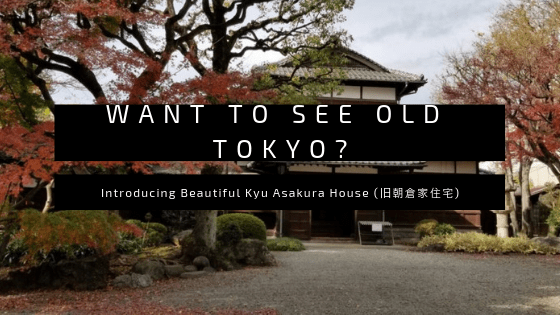If you are visiting Tokyo, 99% chance you are going to go see the Shibuya Crossing. If you are into history and want to see a blast from the past, you should head over to the Daikanyama area of Shibuya and see the Kyu Asakura House. Since you are there and all! One of the Important Cultural Properties you can see in Tokyo.

Important Cultural Properties
Important Cultural Properties? What’s that?! Though there were several laws prior to it, in 1950, the Law for Protection of Cultural Properties was enacted. Within the cultural properties there are many subsets.
- Tangible Cultural Properties
- Intangible Cultural Properties
- Folk Cultural Properties
- Monuments
- Cultural Landscapes
- Groups of Cultural Buildings (Think whole towns)
Within each, they are further broken down. Properties generally fall under the first bullet and can be “Important Cultural Property” (重要文化財 jūyō bunkazai) or if they are really special “National Treasures” (国宝 kokuhō). The 12 Original Castles fall into one of these two categories. They hold important academic, historical and cultural merit for Japan.

Collect them All
If collecting your stamps for the 100 finest castles isn’t enough for you, how about ALL of the important cultural properties? As of writing this, the Agency of Cultural Affairs designated 2, 445 Important Cultural Properties, of which 223 are National Treasures. The number is actually quite larger than that. Why? Because those are “places” and a lot of them have more than one building. Like Himeji Castle with her 80+ Important Cultural Properties. You’ll be busy ;).
Kyu Asakura House (旧朝倉家住宅)
So what makes the Kyu Asakura house special? First of all that “旧” or “Kyu” in the name is just one of the word’s for “old”. She’s a relic from the Taisho Era in Japan. Crammed between the Meiji Period and the Showa period, Taisho was pretty short due to a sickly emperor from 1912-1926. So honestly, not that old when you consider some things in Japan as it was built in 1919. However, it not only survived the 1923 Great Kanto Earthquake but also the fire bombings during WWII. So she’s resilient!

So, it’s the “old” Asakura House, named after the owner, Tojiro Asakura. He served on Shibuya’s council and later in life he was apart of the Tokyo Prefectural council. And yes, it was a private residence. Keep that in mind when you walk through the expanses.
Most of the floors in the two-story mansion are tatami mats so you’ll need to leave your shoes at the front entrance. Built into the hillside, the pictures available for the taking in the garden are definitely worth a stroll.

The details: Where and How much
At only 100 yen for adults, it’s well worth the 30-60 minutes you may spend walking the house and grounds. Open from 10 am to 6 pm most of the year, winter hours shorten due to the
Pin this for later

